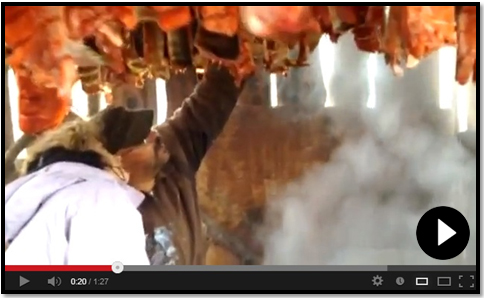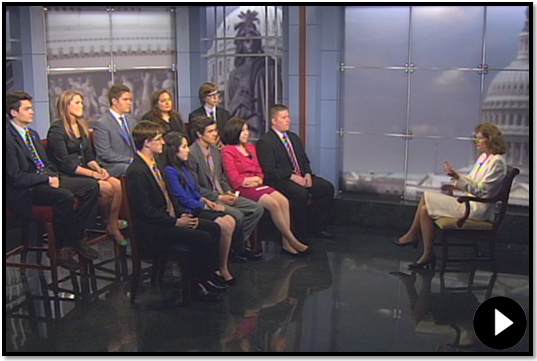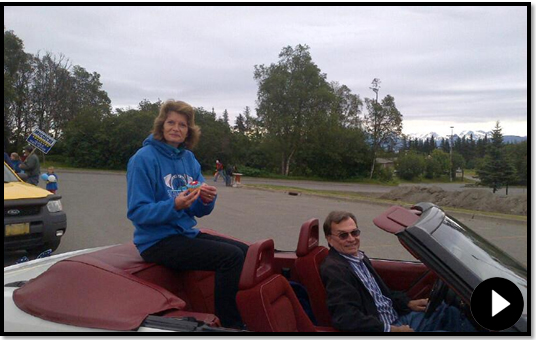Senator Murkowski E-Newsletter for the Week of June 15, 2013
Kuskokwim River Fish Camp Visit
I had a wonderful weekend on the Kuskokwim River at the end of June, visiting nine fish camps to hear from Alaskans about subsistence fishing. The traditional camps I visited – located near Bethel, Akiak, Akiachak, Kwethluk, Kalskag, Aniak and Chuathbaluk – serve as both an important food source and cultural training ground for many Alaska Natives and their families.
Many families spend weeks on end in their fish camps, but high gas prices are impacting some families’ ability to fish and stay in their traditional camps. One family in Chuathbaluk told me that due to fewer salmon returns it now takes as many as a dozen passes with a boat and drift net to catch what they used to in just one drift; each time burning more and more expensive fuel.
CLICK on the image for video of Eric Morgan giving me a tour of his salmon smoke house.
It was important for me to see firsthand what all goes into subsistence fishing. Families come together from across generations to fish, then work together for weeks to dry, salt, and smoke their catch in order to provide for their families throughout the year. Their hard work is truly an amazing sight to see. Unfortunately, historically low salmon runs – especially for the Kings - have really impacted these families and their traditional way of life. But, people are adapting by taking more of one species and allowing the other to escape upstream. I saw a true partnership up and down the Kuskokwim to ensure these salmon are around for generations to come. A huge thank you to everyone on the Kuskokwim River for your genuine hospitality!
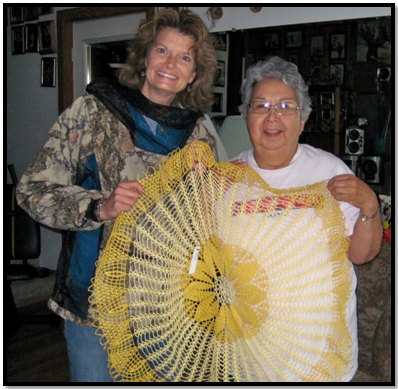
Bea Kristovich shows off this beautifully crocheted tablecloth when I visited Bethel.
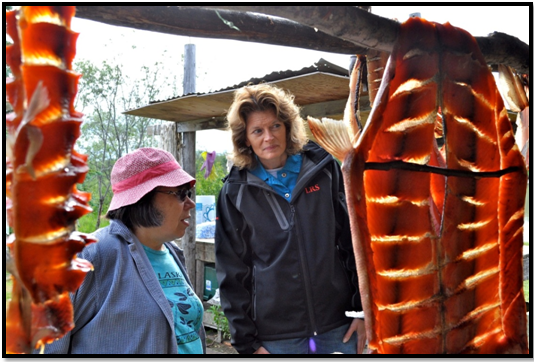
Barb Anvil showed me the salmon her family had caught, cut and were drying in their fish camp near Steamboat Slough just outside of Bethel.
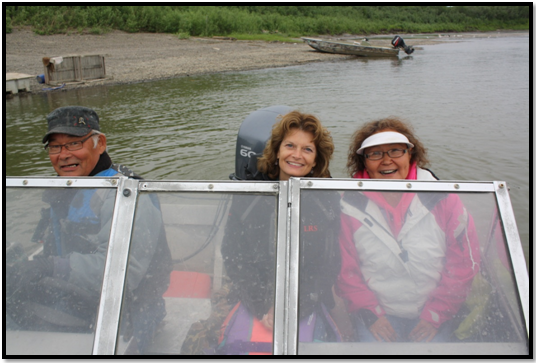
Carl and Angie Morgan joined me on my travels to visit fish camps between Kalskag and Aniak on the Kuskokwim River.

I had a great time talking with 89 year-old Sam Jackson at his fish camp outside of Kwethluk during my trip on the Kuskokwim River.
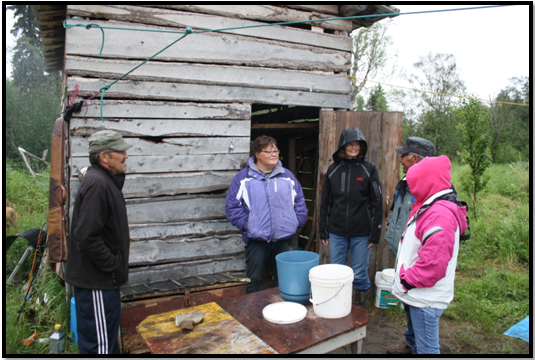
I visited with Carlton and Nancy Morgan at their fish camp above Kalskag on the Kuskokwim. The Morgans, like so many other families on the river, make subsistence fishing a family affair.

Jerry Peterson was my tour guide for my trip to the community of Chuathbaluk, a short, 10 mile boat ride from the hub of Aniak. A beautiful trip, even in the rain.
Washington, D.C. Summer Interns
Each summer, I select 20 high school seniors to serve as interns in my Washington, D.C. office. I introduced you to my first session of enthusiastic interns in my previous e-newsletter. We had the chance to sit down and record an edition of the Alaska Report, where I answered the questions of Alaska’s future leaders. I encourage you to take a look – they covered it all from student loans, energy policy, to government overreach.
CLICK on the image to view my sit down with my first session interns.
This week, I welcomed my second group of summer interns in Washington, D.C. as they have jumped into the daily operations of the United States Senate. Believe it or not, mine is the only office in the U.S. Senate to bring on newly-graduated high school students as full-time help, a tradition that began under Senator Ted Stevens. These 10 Alaskan students are just getting over their jet lag and will spend July assisting in the day-to-day clerical and administrative tasks of a Senate office such as directing mail, speaking with constituents, and assisting staff with research projects.

The second session of summer interns and I met last week to discuss what they should expect over the coming month. My advice to them: “Take advantage of every opportunity to discover the nation’s capitol during their short time here in D.C.”
My second session summer interns are Mitchell Forbes of Bethel; Rachell Gulanes of Unalaska; Emelia Van Wyhe of Copper Center; Kenzie Bjerken of Palmer; Thaddeus Isaacs of Klawock; Maggie Graham of Homer; Connor Hula of Eagle River; Kelsey Cunningham of Hope; John Gutsch and Madeline Moore of Anchorage.
In addition to their work in the office, each day I invite two interns to personally “shadow” me while I attend various meetings, hearings, and votes. This is a great opportunity for them to get up close and personal perspectives on the duties of a U.S. Senator. The interns tell me their shadow day is one of the best parts of their internship.
Student Loan Interest Rates
Speaking of new high school graduates… In this current economic environment, college students in Alaska and across the country face the major obstacles of rising college costs and an incredibly tight job market. This is why here in Congress I’ve supported keeping the interest rate on all federal student loans low, because students deserve certainty when making this major investment in their future.
To keep federal student loan rates low, I have co-sponsored the Bipartisan Student Loan Certainty Act, which would require all newly-issued student loans be set to the U.S. Treasury 10-year borrowing rate plus 1.85% for both subsidized and unsubsidized undergraduate Stafford loans; plus 3.4% for graduate Stafford loans; and plus 4.4% for PLUS loans. The interest rate would be fixed over the life of the loan and the cap on interest rates for consolidated loans would remain at 8.25%. This bipartisan legislation is similar to a plan proposed by President Barack Obama in his 2013 budget and resembles the approach that passed the House of Representatives in May. I prefer an approach that provides a permanent solution for all student loans to a one-year patch that keeps rates low on only some student loans.
It is my hope that we resolve this issue soon because all students deserve affordable student loan rates, while having a sense of certainty in the financial commitment they take on through this major life investment.
Veteran Spotlight: Army Sergeant Tyler Hall
Last month, I released my 13th Veteran Spotlight featuring Sergeant Tyler Hall of Wasilla, a combat engineer and the first Alaskan to be injured in 2003 during Operation Iraqi Freedom.
During his Veteran Spotlight interview, Sergeant Hall says the driving force behind him joining the Army was a generation of Army veterans in his family and the opportunity to travel the world. During his four years in the Army, he traveled the globe until a fateful day in August, 2003 when his caravan was struck by an IED on a road near Tikrit. Hall was told he died and was revived eight separate times.
Sergeant Tyler Hall, U.S. Army Veteran
(Click on image for excerpt of Tyler talking about his brothers-in-arms who saved him in Iraq and support for his fellow veterans, CLICK HERE for the extended interview).
Hall would spend the next ten years undergoing surgeries to reconstruct and repair injuries he received from head to toe. He lost his left leg, suffered a punctured lung, torn aorta, broken back and was badly burned on areas not covered by his flame-resistant uniform. He says his healing process is far from over as he still struggles with post-traumatic stress disorder, but the support he has received helps him cope.
I invite you to watch Tyler Hall tell his story – his brush with death, the road to recovery, receiving the Purple Heart from President George W. Bush, and what life has in store for him next.
My “Veteran Spotlight” project is a monthly focus on an Alaska veteran of American conflicts worldwide to honor and draw well-deserved attention to Alaska’s men and women who served. You can watch them all by clicking here. If you have a family member or friend in the community you think has a story to share, email me at Spotlight@Murkowski.Senate.Gov.
Immigration
While the topic of immigration brings debate on all sides, one point of agreement is that we have a broken immigration system, resulting in 11 million undocumented individuals in our nation. We can’t simply just undo where we are today or continue to close our eyes to the problem; we have to fix our system responsibly, in a thorough and intelligent way.
We are a nation of immigrants; but we are also – just as critically – a nation of laws, and when laws are broken, there is a price to pay. My colleagues and I worked to find a balance between these two realities while navigating the path to bipartisan immigration reform. Earlier this year, when a plan was originally envisioned by the so-called “Gang of Eight,” I told Alaska that I had clear goals in mind: securing our border, streamlining the legal immigration system, and providing a clear and responsible path to citizenship for those already here living and working in the shadows under a form of “de facto amnesty.”
After a lengthy and spirited debate, I believe my Senate colleagues and I arrived at a workable solution to our current situation – one that met my priorities; one with teeth, heart and brains.
When I say the bill has teeth, I’m referring in part to an amendment I co-sponsored to stem the flow of illegal immigrants. It doubles the number of border patrol agents and requires additional fencing along the southwest border. The measure also requires that the government employ technologies like a biometric exit system so we know that visitors who are supposed to depart the U.S. do so.
In terms of brains, the bill includes our nation’s 21st century technological rigor, through mandatory use of the Internet tool e-Verify to make sure that employers only hire authorized employees. We need to crack down on not only those who cross our border, but on those employers who encourage them by looking the other way when hiring undocumented workers.
The bill replaces the current system of “de facto amnesty” with a road map to an earned path to citizenship for those prepared to meet the rigorous requirements in the bill. These requirements include paying fines, continuous work requirements, maintenance of good moral character, paying taxes and learning English. Those who stray from this path will be asked to leave. Let me be clear, the path to citizenship is not an easy one and is estimated to take around 13 years. It requires border security triggers to be in place and certified before applications for green cards can be issued.
Lastly, the bill has heart because these strict rules do not force families to be dissolved and undocumented individuals taken from their brothers, sisters, sons and daughters. As I told the Catholic Hispanic Ministry in May: when our laws separate families and dissolve human dignity, we owe it to our nation’s principles to do what we can to improve those laws.
The bill has now been sent to the House of Representatives, and I am hopeful that they will consider this issue so that our nation can forge ahead with smart policy. For more of my thoughts on this issue, read my recent op-ed that was published in the Alaska Dispatch by clicking here.
Frankenfish Labeling Measure
Last month, Alaska’s wild salmon won a major battle in the fight against genetically modified fish through an amendment I included in the 2014 Agriculture Appropriations bill. That measure would require all Genetically Engineered salmon or “Frankenfish” to be labeled before it is sold to consumers. While I continue to work against the FDA’s ongoing approval process, I am working every possible avenue to ensure consumers know exactly what products they are purchasing should approval happen.
My amendment would ensure that millions of Americans know the difference between wild salmon from our streams and oceans and those created in science labs and holding pens. Alaska’s world renowned wild salmon stock and the hard-work of fishermen selling a real, wild product need to be protected from imposters trying to peddle an inferior product.
For years I have said that Frankenfish does not belong on our dinner plates, and I will continue to spread the word to my colleagues here in the Senate. Listen here to the Senate Appropriations Committee hearing where my amendment was adopted.
Independence Day on the Lower Kenai Peninsula
I had a great time celebrating our nation's Independence Day in both Seldovia and Homer over the 4th. I was named Old Crab 2013 in Seldovia (watch me accepting this tremendous honor by clicking above) and served as Grand Marshal of the Homer Independence Day Parade. Thank you to everyone in the Kachemak Bay area for the warm reception!
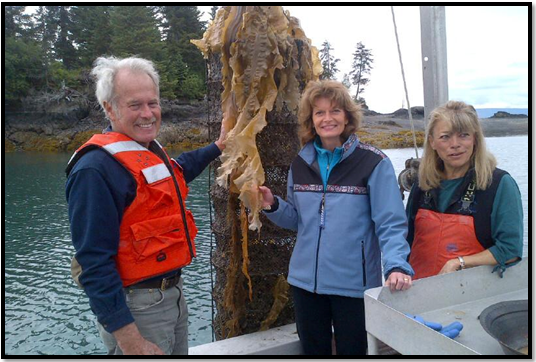
My tour of the Moss Island Oyster Farm in Peterson Bay last week was a great success. Ron and Marie Bader know that a lot of work goes into growing these tasty oysters and I love that it's another sustainable Alaskan fishery.
Around Alaska

Verne and I visited with Bella Hammond, wife of our the late Governor Jay Hammond, while we were at her homestead on Lake Clark.
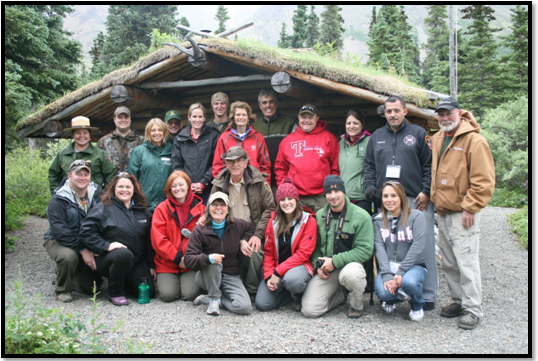
Visiting with Wounded Veterans and their spouses at Operation Heal Our Patriots in the Lake Clark National Park and Preserve.
Alaskans in Washington, D.C.
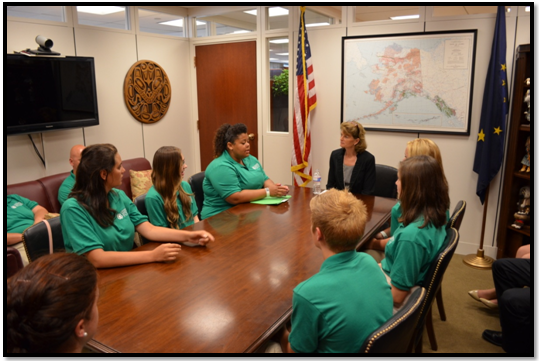
A group of young Alaskans from the Fairbanks area came to visit me as part of the National 4-H Youth Conference here in Washington, D.C. I thanked these students for representing our state so well as they serve as “Alaskan Ambassadors” at their conference – teaching others all about our great state.
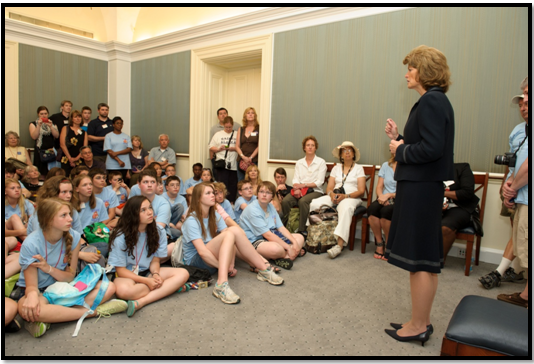
I spoke with a group of 39 Alaskan students this June visiting the nation’s capitol for National History Day. I’m told this is the largest Alaskan group ever to attend this conference. Check out how they did as they competed against students from across the country by clicking here.
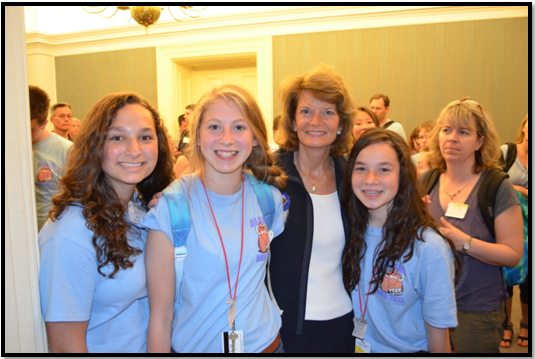
National History Day students Kate, Emmalynn, and Delana of Anchorage pose for a quick photo after our meeting.
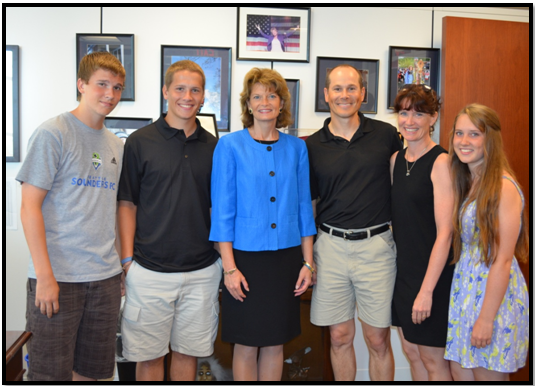
The Evans family of Anchorage stopped by my office for a tour of the U.S. Capitol given by my staff. I encourage all Alaskans visiting Washington, D.C. to do the same – you can request tours by visiting the DC Tour Request section on my website.

